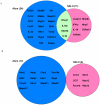Extracellular matrix from porcine small intestinal submucosa (SIS) as immune adjuvants
- PMID: 22087247
- PMCID: PMC3210130
- DOI: 10.1371/journal.pone.0027083
Extracellular matrix from porcine small intestinal submucosa (SIS) as immune adjuvants
Abstract
Porcine small intestinal submucosa (SIS) of Cook Biotech is licensed and widely used for tissue remodeling in humans. SIS was shown to be highly effective as an adjuvant in model studies with prostate and ovarian cancer vaccines. However, SIS adjuvanticity relative to alum, another important human-licensed adjuvant, has not yet been delineated in terms of activation of innate immunity via inflammasomes and boosting of antibody responses to soluble proteins and hapten-protein conjugates. We used ovalbumin, and a hapten-protein conjugate, phthalate-keyhole limpet hemocyanin. The evaluation of SIS was conducted in BALB/c and C57BL/6 mice using both intraperitoneal and subcutaneous routes. Inflammatory responses were studied by microarray profiling of chemokines and cytokines and by qPCR of inflammasomes-related genes. Results showed that SIS affected cytokine and chemokines microenvironments such as up-regulation of IL-4 and CD30-ligand and activation of chemotactic factors LIX and KC (neutrophil chemotactic factors), MCP-1 (monocytes chemotactic factors), MIP 1-α (macrophage chemotactic factor) and lymphotactin, as well as, growth factors like M-CSF. SIS also promoted gene expression of Nod-like receptors (NLR) and associated downstream effectors. However, in contrast to alum, SIS had no effects on pro-inflammatory cytokines (IL-6, IL-1β, TNF-α) or NLRP3, but it appeared to promote both Th1 and Th2 responses under different conditions. Lastly, it was as effective as alum in engendering a lasting and specific antibody response, primarily of IgG1 type.
Conflict of interest statement
Figures





Similar articles
-
Effects of small intestinal submucosa (SIS) on the murine innate immune microenvironment induced by heat-killed Staphylococcus aureus.PLoS One. 2012;7(11):e48724. doi: 10.1371/journal.pone.0048724. Epub 2012 Nov 26. PLoS One. 2012. PMID: 23189134 Free PMC article.
-
Immune enhancement by novel vaccine adjuvants in autoimmune-prone NZB/W F1 mice: relative efficacy and safety.BMC Immunol. 2011 Oct 24;12:61. doi: 10.1186/1471-2172-12-61. BMC Immunol. 2011. PMID: 22024358 Free PMC article.
-
Xenogeneic extracellular matrix grafts elicit a TH2-restricted immune response.Transplantation. 2001 Jun 15;71(11):1631-40. doi: 10.1097/00007890-200106150-00024. Transplantation. 2001. PMID: 11435976
-
Interleukin 12 and innate molecules for enhanced mucosal immunity.Immunol Res. 1999;20(3):207-17. doi: 10.1007/BF02790404. Immunol Res. 1999. PMID: 10741861 Review.
-
Alum adjuvant: some of the tricks of the oldest adjuvant.J Med Microbiol. 2012 Jul;61(Pt 7):927-934. doi: 10.1099/jmm.0.038943-0. Epub 2011 Dec 15. J Med Microbiol. 2012. PMID: 22174375 Review.
Cited by
-
Tumor-associated macrophages: Prognostic and therapeutic targets for cancer in humans and dogs.Front Immunol. 2023 Apr 5;14:1176807. doi: 10.3389/fimmu.2023.1176807. eCollection 2023. Front Immunol. 2023. PMID: 37090720 Free PMC article. Review.
-
Integrative cartilage repair using acellular allografts for engineered structure and surface lubrication in vivo.NPJ Regen Med. 2024 Sep 28;9(1):25. doi: 10.1038/s41536-024-00367-x. NPJ Regen Med. 2024. PMID: 39341829 Free PMC article.
-
Biologic Mechanisms of Macrophage Phenotypes Responding to Infection and the Novel Therapies to Moderate Inflammation.Int J Mol Sci. 2023 May 6;24(9):8358. doi: 10.3390/ijms24098358. Int J Mol Sci. 2023. PMID: 37176064 Free PMC article. Review.
-
Extracellular Matrix Scaffold-Assisted Tumor Vaccines Induce Tumor Regression and Long-Term Immune Memory.Adv Mater. 2024 Apr;36(15):e2309843. doi: 10.1002/adma.202309843. Epub 2024 Feb 11. Adv Mater. 2024. PMID: 38302823 Free PMC article.
-
Engaging adaptive immunity with biomaterials.J Mater Chem B. 2014 May 7;2(17):2409-2421. doi: 10.1039/C3TB21549K. J Mater Chem B. 2014. PMID: 24729870 Free PMC article.
References
-
- Morel S, Didierlaurent A, Bourguignon P, Delhaye S, Baras B, et al. Adjuvant System AS03 containing alpha-tocopherol modulates innate immune response and leads to improved adaptive immunity. Vaccine. 2011;29:2461–2473. - PubMed
-
- Bornstein P, Sage EH. Matricellular proteins: extracellular modulators of cell function. Current Opinion in Cell Biology. 2002;14:608–616. - PubMed
-
- Coombe D. Extracellular matrix volume 1: Tissue function volume 2: Molecular components and interactions. Immunol Cell Biol. 1998;76:114–115.
-
- Sottile J. Regulation of angiogenesis by extracellular matrix. Biochimica et Biophysica Acta (BBA) - Reviews on Cancer. 2004;1654:13–22. - PubMed
Publication types
MeSH terms
Substances
LinkOut - more resources
Full Text Sources
Other Literature Sources
Medical
Research Materials
Miscellaneous

